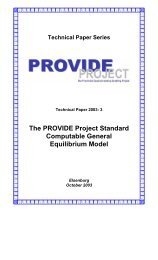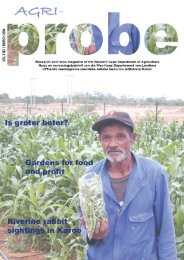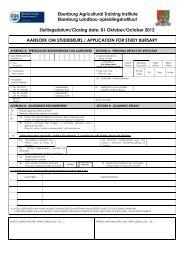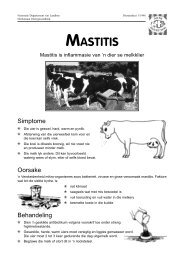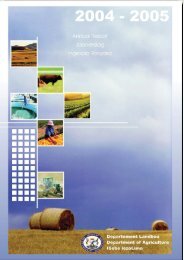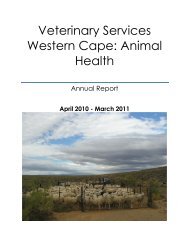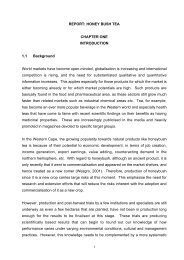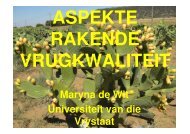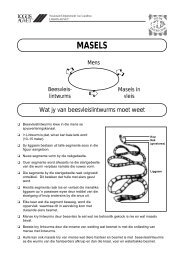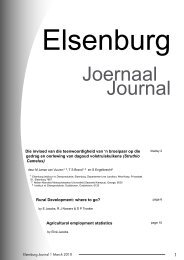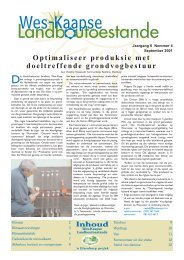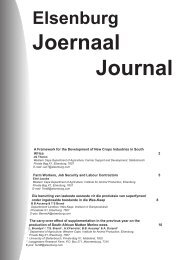AgriPROBE June 2007 - Department of Agriculture: Western Cape
AgriPROBE June 2007 - Department of Agriculture: Western Cape
AgriPROBE June 2007 - Department of Agriculture: Western Cape
You also want an ePaper? Increase the reach of your titles
YUMPU automatically turns print PDFs into web optimized ePapers that Google loves.
<strong>AgriPROBE</strong> <strong>June</strong> <strong>2007</strong>
ditorial<br />
REdaksioneel<br />
<strong>AgriPROBE</strong><br />
Quaterly newsletter <strong>of</strong> the <strong>Western</strong> <strong>Cape</strong><br />
Die winter skuif nader en daarmee saam<br />
die behoefte aan ’n lekker kaggelvuurtjie, ’n<br />
glasie dieprooi port (ek bedoel ...) en ’n bord<br />
vol kaas en beskuitjies. Vir dié van ons wat<br />
al ’n tydjie binne die landbousektor bedrywig<br />
is, is hierdie prentjie maar net nog ’n landbouprentjie<br />
met sy wyn- en suiwel- en koringprodukte.<br />
Sonder landbouprodukte sou die<br />
lewe nie net in die wintermaande maar bra<br />
saai wees nie, maar sou die mensdom nie kos<br />
op die tafel hê nie. (Ek preek nou natuurlik<br />
vir die bekeerdes oor die belangrikheid van<br />
landbou.)<br />
Ontmoet drie van die Departement se<br />
nuwe voorvatters op bladsy 0. Dudley Adolph se besigheidsbenadering<br />
tot grondhervorming is inderdaad<br />
verfrissend en Dr Ilse Trautmann is ’n navorser in murg en<br />
been wat nie bang is om haar sê te sê om navorsing aan<br />
die groot klok te hang nie. Dr Gininda Msiza, die nuwe<br />
programbestuurder vir Veertsenydienste is entoesiasties<br />
oor die uitdagings wat voorlê.<br />
It’s also not too late to read Dr Philip Botha’s article<br />
on page 6 about planning for winter pastures. On pages<br />
4 onwards Dr Carel Muller says: ‘the genetic merit <strong>of</strong> a<br />
dairy herd is mainly determined by the quality <strong>of</strong> the bulls.<br />
Therefore, the selection <strong>of</strong> bulls has a direct impact on the<br />
long term income.’ Defi nitely not to be missed if you plan<br />
on making money with diary cattle.<br />
Enjoy the evenings in front <strong>of</strong> the fi replace!<br />
Charlene Nieuwoudt<br />
Redakteur<br />
If you need any <strong>of</strong> the articles in this magazine in<br />
any other <strong>of</strong>fi cial language <strong>of</strong> the <strong>Western</strong> <strong>Cape</strong>, we<br />
would be happy to arrange translation for you. Please<br />
contact the Editor on Tel. 02 808 5008.<br />
Indien u enige van die artikels in hierdie tydskrif in een<br />
van die ander amptelike tale van die Wes-Kaap benodig,<br />
kan u ons gerus kontak om die vertaling daarvan<br />
vir u te reël. Kontak die redakteur by Tel. 02 808 5008.<br />
Ukuba ufuna naliphina inqaku elikule magazini ngolunye<br />
ulwimi olusesikweni kwiilwimi zeNtshona Koloni, siya kukulungiselela<br />
uguqulelo-lwimi lenqaku elo. Nceda ke uqhagamshelane<br />
noMhleli kule nombolo yomnxeba:- 02 808 5008.<br />
<strong>AgriPROBE</strong> Junie <strong>2007</strong><br />
<strong>Department</strong> <strong>of</strong> <strong>Agriculture</strong>, distibuted free <strong>of</strong><br />
charge to subscribers.<br />
EDITORIAL<br />
Charlene Nieuwoudt (Editor)<br />
Liesl Muller<br />
Dr Ilse Trautmann<br />
ADVERTISEMENTS<br />
Gizelle van Wyk<br />
Tel. (02 ) 808 5022<br />
E-mail: gizellevw@elsenburg.com<br />
ADDRESS<br />
Private Bag X<br />
ELSENBURG<br />
7607<br />
Tel (02 ) 808 5008<br />
Fax (02 ) 808 5000<br />
E-mail: charlenen@elsenburg.com<br />
REPRODUCTION<br />
CREDA<br />
PRINTING<br />
CREDA<br />
Subscriptions<br />
For free subscription to this quarterly magazine<br />
<strong>of</strong> the <strong>Western</strong> <strong>Cape</strong> <strong>Department</strong> <strong>of</strong> <strong>Agriculture</strong>,<br />
forward your details to Magriet de Lange at:<br />
Tel (02 ) 808 76 3<br />
Fax (02 ) 808 7605<br />
E-mail magrietadl@<br />
elsenburg.com<br />
ISSN: 1810-9799<br />
2<br />
I
ndex<br />
Inhoudsopgawe<br />
3<br />
Voorbladstorie<br />
Natuurvriendelike vee-Wagter<br />
p 8<br />
SPESIALE ARTIKELS SPECIAL FEATURES<br />
4 Kies bulle vir wins<br />
6 Genetika toekenning vir Outeniqua Jerseys<br />
8 Natuurvriendelike vee-Wagter<br />
10 Three new leaders for <strong>Agriculture</strong><br />
11 Adjust concentrate feeding to pasture quality<br />
12 Putting our thinking caps on<br />
14 Market information to boost access<br />
16 Beplan nou reeds winterweiding<br />
8 Say Cheese!<br />
BROKKIES BITS AND PIECES<br />
15 Testing: organic or inorganic?<br />
17 Koebeeberg kry water<br />
18 International women in agriculture join forces<br />
18 Antoinette Parks: my storie<br />
19 Community service for vets?<br />
ELSENBURG JOERNAAL / JOURNAL<br />
2 Research performed in the <strong>Western</strong> <strong>Cape</strong> area <strong>of</strong><br />
South Africa on alternative plant protein sources<br />
in pig diets<br />
7 A review on research performed in South Africa<br />
on small grains as energy source in pig diets<br />
Agricultural land prices in the <strong>Western</strong> <strong>Cape</strong><br />
reveals its dynamic character<br />
Partnership<br />
success<br />
The Tulbagh Farm Worker’s Trust<br />
(TFT) is a representative organisation<br />
<strong>of</strong> farms in the Tulbagh area.<br />
The TFT owns and manages an asset<br />
known as the D’Agen Versorgingsoord.<br />
During 2003 the farm workers in the Tulbagh<br />
area found themselves fi nancially strapped and<br />
urgently required training and skills development. In<br />
response, the TFT bought the D’Agen complex situated<br />
outside Tulbagh on the Wintershoek road. The<br />
complex consists <strong>of</strong> a community hall, crèche and<br />
playground, an ablution block, a caretaker’s house<br />
and a rugby fi eld. The TFT received funding from the<br />
Independent Development Trust (IDT).<br />
The crèche is registered for 60 children, but<br />
comes under pressure during harvesting season<br />
when more than 200 children have to be cared for.<br />
With funding from the <strong>Department</strong> <strong>of</strong> <strong>Agriculture</strong><br />
and Dried Fruit Technical Services, the <strong>Cape</strong> Women’s<br />
Forum was approached to be the facilitating<br />
body. They performed a participative needs assessment<br />
with staff <strong>of</strong> the crèche. 40 mothers were<br />
trained in home and family management skills. An<br />
empowerment programme for 4-6 year old children,<br />
highlighting the four emotions (joy, anger, loss and<br />
fear), and how to express these emotions in a constructive<br />
way, and to build a positive self-image, was<br />
also presented. Children were also given information<br />
about HIV/AIDS, alcohol and other drugs.<br />
‘This is an excellent example <strong>of</strong> the power <strong>of</strong> cooperation<br />
and working in partnership with individuals<br />
and institutions that have the same passion for<br />
development and empowerment,’ says Danie Niemand,<br />
director <strong>of</strong> Farm Worker Development at the<br />
<strong>Department</strong>.<br />
On the photograph: Mr Cobus Dowry, Drisa du<br />
Toit (headmistress) and Jan Demas, a parent.<br />
<strong>AgriPROBE</strong> <strong>June</strong> <strong>2007</strong>
In die melkbeesbedryf behoort maksimum wins die doelwit<br />
te wees. Elke produsent (en sy adviseur) het egter<br />
sy eie mening hoe om daarby uit te kom.<br />
Sommiges meen dat dit alleen deur die hoogste<br />
melkproduksie per koei verkry kan word, terwyl ander<br />
weer voel dat dit eerder teen ’n laer voedings koste per<br />
koei moet wees. Hierdie uiteenlopende sienings impliseer<br />
eintlik verskillende seleksie- en be stuurs doelwitte en dit<br />
word dan ook gesien op die manier hoe bulle geselekteer<br />
en koeie gevoer word.<br />
Dit is waarom daar onder produsente gestry word<br />
oor watter bulle die ‘regte’ keuse is. Verteenwoordigers<br />
van rasgenootskappe, semenagente van verskillende<br />
maatskappye en wetenskaplikes het elk hul eie mening.<br />
Ongeag u benadering, vir maksimum wins moet daar ’n<br />
balans wees tussen die inkomste en die uitgawe van ’n<br />
melkery. ’n Wins gewende melkery staan ho<strong>of</strong>saaklik op<br />
drie bene, naamlik die hoogste moontlike melkproduksiepeil<br />
en –samestelling per koei binne ’n bepaalde bestuurstelsel,<br />
koeie wat gereeld kalf (elke 2 tot 3 maande)<br />
en dan moet elke koei wat in die kudde opgeneem word,<br />
so lank as moontlik lewe. Dit impliseer dus dat ’n ge-<br />
paste seleksiedoelwit vir ’n kudde op die teeltwaarde van<br />
bulle vir die melkproduksie, -samestelling, vrugbaarheid<br />
en produktiewe leeftyd van hul dogters gebaseer moet<br />
wees.<br />
<strong>AgriPROBE</strong> Junie <strong>2007</strong><br />
Waarvolgens word bulle geselekteer?<br />
Ongeag die feit dat meer as 0% van die inkomste van ’n<br />
melkery van die verkope van melk afkomstig is, is dit interessant<br />
om te sien waarvolgens bulle geselekteer word.<br />
In die eerste plek is produsente dikwels vaag wanneer<br />
hulle hul seleksiedoelwit vir die kudde moet beskryf. Eienskap<br />
pe waarna gewoonlik verwys word is onder andere<br />
die volgende: die be trou baarheid van ‘syfers’ en hoe die<br />
uiers, bene en pote van die dogters van bulle lyk. Sekere<br />
bouvorm eien skappe soos hoë sitbene en die grootte van<br />
koeie geniet ook aandag. Blaai ’n mens deur die joernale<br />
van rasgenootskappe, kom uitdrukkings soos mediumraamkoeie,<br />
voldoende lig gaams diepte, ’n goed gevormde<br />
kruis en lende, goed geplaasde bene en draaibene, uiers<br />
wat goed aangeheg en hoog bo die hak is, na vore. Dit lyk<br />
dus as<strong>of</strong> die oogmerk by die meeste produsente eerder is<br />
om koeie te teel wat aan bepaalde bouvormeienskappe<br />
voldoen as om te konsentreer op die hoeveelheid en die<br />
kwaliteit van die melk wat die koeie moet produseer.<br />
Daar is nie baie eenstemmigheid oor hoeveel waarde<br />
aan bouvormeienskappe as seleksiedoelwit geheg moet<br />
word nie. Vir baie jare word die ideale bouvorm van koeie<br />
deur rasgenootskappe nage streef en dit is belangrik vir<br />
produsente wat aan skoue deelneem. Daar is geen twyfel<br />
nie dat daar baie koeie is met hoë melkproduksiepeile<br />
Kies bulle vir wins<br />
4
wat ook feitlik ideale bouvormeienskappe het. Dit beteken<br />
egter nie noodwendig dat die omgekeerde hiervan ook<br />
die geval is nie. Om dus koeie met ’n ‘ideale’ bouvorm te<br />
probeer teel, beteken nie dat hulle ook hoë melkproduksies<br />
gaan lewer nie. Elke eienskap het sy eie oorerfl ikheidswaarde<br />
en die invloed van die omgewing daarop<br />
is vir elkeen verskillend. Wetenskaplikes het wel oor die<br />
laaste aantal jare vasgestel dat koeie met sekere ‘goeie’<br />
bouvorm eienskappe langer in kudde bly. As gevolg van<br />
hierdie eienskappe is koeie beter in staat om die be stuursdruk<br />
in ’n melkery te weerstaan. Hoewel die genetiese korrelasies<br />
tussen produktiewe leeftyd en eienskappe soos<br />
uiers, bene en pote positief is, is die belangrikste eienskap<br />
wat koeie in die kudde hou steeds die hoeveelheid melk<br />
wat hulle produseer. Niemand sal tog ’n koei met ’n hoë<br />
melkproduksie uitskot omdat sy bouvormfoute het nie.<br />
’n Lang lewe verseker ook nie dat koeie oor hul leeftyd<br />
baie winsgewend <strong>of</strong> doeltreffend sal wees nie. Daar is<br />
reeds in die vyftigerjare beraam dat die doeltreffendheid<br />
<strong>of</strong> winsgewendheid van koeie positief beïnvloed word<br />
deur beide die hoeveelheid melk wat hulle produseer en<br />
hoe lank hulle lewe (Tabel ). Hiervolgens blyk dat die<br />
doeltreffendheid van koeie toeneem met meer laktasies<br />
asook die hoeveelheid melk wat per laktasie geproduseer<br />
word. ’n Lae produserende koei moet baie langer as ’n<br />
hoër produserende koei in die kudde bly om ’n<br />
vergelykbare leeftydsdoeltreffendheid te kan<br />
lewer. ’n Verdere probleem is die feit dat<br />
die oorerfl ikheid van produktiewe leeftyd<br />
by koeie laag is (8.5%). Dit impliseer<br />
dat produktiewe leeftyd ho<strong>of</strong>saaklik<br />
deur omgewing- en bestuursfaktore<br />
beïnvloed word.<br />
In vergelyking hiermee<br />
is die oorerfl ikheid vir<br />
melkproduksie aansienlik<br />
hoër, naamlik 25%,<br />
en daarom sou dit makliker<br />
wees om melkproduksie as<br />
produktiewe leeftyd te verbeter.<br />
Daar is verskillende maniere om die<br />
doeltreffendheid <strong>of</strong> winsgewendheid van<br />
koeie te bereken. Die beste metode sou wees<br />
om ’n koei se totale melk-, vet <strong>of</strong> proteïenproduksie oor<br />
haar leeftyd te verreken teenoor die totale hoeveelheid<br />
voer wat sy oor haar leeftyd ingeneem het. Dit sluit in alle<br />
voer wat sy as ’n groeiende vers en as droë en lakterende<br />
koei ingeneem het. Ander berekeninge soos daaglikse<br />
melkproduksie gedeel deur voerinname is meer ’n aanduiding<br />
van voedingsbestuur en moet as sulks gebruik<br />
word.<br />
’n Teeltdoelwit vir maksimum wins<br />
Aangesien die melkproduksie en –samestelling van<br />
koeie so ’n groot effek op hul winsgewendheid en leeftydproduksie<br />
het, behoort die teeltwaardes vir melkproduksieeienskappe<br />
die basis van die seleksie van bulle te wees.<br />
Die maklikste metode sou wees om die beskikbare bulle<br />
van ’n bepaalde semenmaatskappy volgens teeltwaardes<br />
vir melkproduksie van hoog na laag te rangskik. ’n Kombinasie<br />
van die teeltwaardes vir vet- en proteïenproduksie<br />
kan ook gebruik word. Beskikbare indekse wat<br />
’n kombinasie is van ’n aantal eienskappe<br />
kan ook gebruik word.<br />
In hierdie lys moet die<br />
5<br />
’n Melkbeesboerdery is ’n<br />
hoogs intensiewe besigheid<br />
wat teen ’n hoë koste op<br />
die been gebring moet<br />
word, terwyl kennis van ’n<br />
wetenskaplike en praktiese<br />
aard nodig is om dit<br />
suksesvol te bedryf.<br />
afwyking van elke bul ten opsigte van vet- en proteïenpersentasie<br />
aangeteken word. Die betroubaarheid van<br />
die teeltwaardes asook die koste van ’n strooitjie kan ook<br />
teenoor elke bul aangeteken word. Uit hierdie lys kan so<br />
3 tot 4 bulle vir ’n 00-koeikudde uitgesoek word. Besluit<br />
vooraf wat die maksimum prys is wat vir ’n strooitjie betaal<br />
gaan word asook die maksimum afwyking vir vet- en proteïenpersentasie.<br />
By Holsteins moet vir verse verkieslik<br />
bulle met ’n hoë kalwingsgemak gekies word. Tydens die<br />
kombinasie van bulle en koeie moet afwykende bouvormeien<br />
skappe in gedagte gehou word. Dit beteken dat bulle<br />
waarvan die na ge slag minder goeie uiers het, nie met<br />
koeie gepaar word wat reeds swak uiers het nie.<br />
’n Meer wetenskaplike metode van bulseleksie is om<br />
’n kommersiële paringsprogram te gebruik. Bulle vir die<br />
Elsenburg Holstein- en Jerseykuddes word op hierdie<br />
wyse geselekteer. Bulle wat vir die pa rings program oorweeg<br />
word moet aan ’n bepaalde minimum teeltwaarde<br />
vir melkproduksie voldoen. Daarmee saam moet hul<br />
afwykings vir vet- en proteïenpersentasie van die dogters<br />
ook nie meer as bepaalde maksimum waardes wees nie.<br />
Bouvorm eienskappe van die dogters van bulle word ook<br />
in ag geneem. Die program gebruik die oorerfl ik hede van<br />
3 bouvormeienskappe, hul ekonomiese belangrikheid en<br />
die genetiese korrelasies met produksie-eienskappe in die<br />
kombinasie van bulle met koeie in die kudde.<br />
Hoewel ’n paringsprogram geriefl ik is en op wetenskaplike<br />
beginsels berus, is baie produsente huiwerig om dit<br />
te gebruik aangesien hulle voel dat hulle dan nie meer<br />
‘beheer’ oor die keuse van bulle het nie.<br />
Spesiale bulle word dikwels aan die bedryf beskikbaar<br />
gestel. Voordat ’n aantal strooitjies van so ’n bul aangekoop<br />
word, moet sy teeltwaarde eers met die bestaande<br />
bulle vergelyk word om te bepaal <strong>of</strong> die bul die moeite<br />
Tabel 1. Die doeltreffendheid van koeie soos beïnvloed<br />
deur die aantal laktasies voltooi en melkproduksie<br />
per laktasie<br />
Doeltreffendheid (%) per laktasie<br />
Laktasieproduksie (kg) 3 4 7 10<br />
2730 4.4 5.2 6.6 7.3<br />
3640 7.3 8.3 20.0 20.8<br />
4545 .8 2 .0 22. 23.8<br />
<strong>AgriPROBE</strong> <strong>June</strong> <strong>2007</strong>
Genetika toekenning vir<br />
Outeniqua Jerseys<br />
Die Wes-Kaapse Departement van Landbou het<br />
tydens die onlangse SA Jersey prysuitdelingdinee<br />
in Bloemfontein met die tr<strong>of</strong>ee vir die hoogste<br />
punte in die afdeling vir genetiese meriete weggestap. Die<br />
kudde wat dié trotse prestasie behaal en sodoende die SA<br />
Stamboek wisseltr<strong>of</strong>ee ontvang het, is die Jerseykudde<br />
van die Diereproduksie Navorsingstrust op die Departement<br />
se Outeniqua navorsingsplaas buite George.<br />
Volgens dr. Robin Meeske, spesialiswetenskaplike<br />
(Diereproduksie) op die Outeniqua navorsingsplaas, is<br />
Bulle vir wins<br />
werd is om te gebruik. Ongelukkig het die verkope van<br />
die semen van KI-bulle net soos enige ander kommoditeit<br />
geraak. Die prys van strooitjies is baie afhanklik van vraag<br />
en aanbod. In dien die aanvraag vir semen van ’n bepaalde<br />
bul hoog is (soos wanneer die aantal strooitjies beperk<br />
raak), sal die koste van die strooitjies toeneem ongeag<br />
wat die genetiese meriete vir melkproduksie vir so ’n bul<br />
is. Met aankoop en gebruik van semen word twee dinge<br />
gelyktydig gedoen, die koei word beset sodat sy later weer<br />
in melk kan kom en tydens die bevrugtingsproses word<br />
nageslag met ’n bepaalde genetiese meriete geskep. Dit<br />
is waar genetiese ver andering in die kudde plaasvind. Semenpryse<br />
moet daarom nie gebruik word as ’n aanduiding<br />
van die genetiese meriete van bulle nie. ’n Maklike manier<br />
om hierby verby te kom is om die teeltwaarde van ’n bul<br />
vir melkproduksie te deel deur die prys van die strooitjie.<br />
Hiermee word ’n aanduiding gekry van die genetiese<br />
waarde van die semen.<br />
Met die ont wikkeling van teeltwaardeberamings is daar<br />
’n groot aantal eienskappe waarvolgens bulle geselekteer<br />
kan word. Hierdie eienskap pe word al hoe meer in indekse<br />
saamgevoeg. In Suid-Afrika byvoorbeeld, gebruik<br />
SA Jersey die sogenaamde SAINET-indeks,<br />
terwyl in die VSA ’n indeks<br />
’net Merit’<br />
baie sterk<br />
aan- aan-<br />
<strong>AgriPROBE</strong> Junie <strong>2007</strong><br />
dit die eerste jaar dat hierdie tr<strong>of</strong>ee toegeken word. Die<br />
kudde se genetiese meriete is beoordeel deur die gemiddelde<br />
SAINET (amptelike seleksie-indeks van Jersey SA)<br />
van die volwasse koeie en verse met ander kuddes in<br />
dieselfde groep te vergelyk soos wat vir produksie-evaluering<br />
bepaal word. Beoordeling het ook die vordering van<br />
die verse teenoor die volwasse koeie bygereken.<br />
Volgens dr Meeske is hierdie toekenning grootliks<br />
bereik deur die kundige insette van die kuddebestuurder,<br />
Mnr Gerrit van der Merwe. Gerrit is reeds 36 jaar vir die<br />
beveel word. Hiermee word verskillende eienskappe soos<br />
proteïen- en vetproduksie, produktiewe leeftyd, somatiese<br />
seltelling, uiersamestelling, bene en pote, grootte, vrugbaarheid<br />
en kalwingsgemak van koeie in ’n indeks saamgevoeg.<br />
Kan ’n kuddebul gebruik word?<br />
’n Selfgeteelde bul <strong>of</strong> u buurman se bul moet ver kies lik<br />
nie in die telingsprogram van ’n melkkudde gebruik word<br />
nie. Behalwe vir die feit dat ’n kuddebul lewens gevaarlik<br />
kan wees, is daar net beperkte inligting oor die genetiese<br />
meriete van so ’n dier beskikbaar. Indien ’n bul aangekoop<br />
word uit ’n kudde wat aan melkaantekening deelneem,<br />
kan ’n voorspelde teeltwaarde beraam word. Daar is egter<br />
steeds geen inligting oor die kalwingsgemak en ander<br />
eienskappe van die bul nie. Indien stamboominligting van<br />
die bul ontbreek, is die akkuraatheid van die beraamde<br />
teeltwaarde ook nie baie hoog nie.<br />
Die dekkingskoste van ’n kuddebul is elk geval nie<br />
veel laer as die koste van KI nie. Dit is net makliker om ’n<br />
kuddebul te gebruik eerder as om koeie te KI. Die kans is<br />
ook meer as 80% dat die teeltwaarde van ’n kuddebul laer<br />
sal wees as die meeste KI-bulle. Indien ’n bul wel aangekoop<br />
moet word, moet dit verkieslik uit ’n kudde kom met<br />
’n hoër genetiese meriete as u eie kudde. Daar moet nie<br />
meer as 5-20% van die koeie in die kudde wees wat<br />
na ge slag van al die kuddebulle is nie. Bulle moet ook gereeld<br />
vervang word omdat hul genetiese waarde onseker<br />
is.<br />
Die genetiese meriete van ’n melkkudde word ho<strong>of</strong>saak<br />
lik bepaal deur die bulle wat in die kudde gebruik<br />
word en bulseleksie is daarom gerig op die langtermyn<br />
inkomste van ’n melkery. Die groot hoe veelheid genetiese<br />
inligting wat vir elke bul beskikbaar is kan verwarrend<br />
wees, maar dit is moontlik om met ’n eenvoudige<br />
seleksiepraktyk steeds goeie genetiese vordering in u<br />
kudde te maak. Dit is egter uiters belangrik dat produsente<br />
aan melkaantekening deelneem sodat vorder-<br />
ing gemonitor kan word.<br />
Vir meer inligting, kontak Dr Carel Muller by 021<br />
808 5228 <strong>of</strong> carelm@elsenburg.com Besoek gerus<br />
ook milkproduction@elsenburg.com op die elsenburg.com<br />
webtuiste.<br />
6
Mnr Gerrit van der Merwe,<br />
kuddebestuurder op Outeniqua<br />
navorsingsplaas, poseer<br />
trots met die SA Stamboek<br />
wisseltr<strong>of</strong>ee by die wenkudde.<br />
bestuur en teling van die kudde op<br />
Outenqua verantwoordelik. Deur sy<br />
toedoen is beproefde bulle met ’n hoë<br />
teeltwaarde vir bottervet en proteïen<br />
geselekteer terwyl bulle met ’n negatiewe<br />
teeltwaarde vir dié eienskappe<br />
vermy is. Met sy kennis van Jersey<br />
koeie het hy ook veral aandag gegee aan goeie bouvorm<br />
met groot klem op die uier, uieraanhegting, hoewe en<br />
bene. Volgens Gerrit was sy benadering om te belê in<br />
goeie genetika. Die uitgangspunt was om goeie semen<br />
van beproefde bulle bekom. Semenkoste word dikwels as<br />
’n hoë koste en struikelblok vir teling gesien. Volgens Gerrit<br />
is semenkoste in verhouding met die totale grootmaakkoste<br />
van ’n vers, laag. Indien ’n ekstra R 50 op semen<br />
gespandeer word om ’n vervangingsvers te verkry, is dit<br />
slegs 3.3% van die totale versgrootmaakkoste. Hierdie<br />
ekstra koste is ’n goeie belegging. Indien die vers oor<br />
die eerste laktasie net 200kg meer melk produseer is die<br />
semenkoste reeds verhaal.<br />
Volgens dr. Meeske word die Jersey kudde op Outeniqua<br />
vir vraaggedrewe navorsing aangewend met die<br />
doelwit om die winsgewendheid van melkproduksie vanaf<br />
aangeplante weiding te verhoog. Die sukses van die<br />
navorsingsprogram op Outeniqua navorsingplaas word<br />
7<br />
Die Jersey kudde<br />
op Outeniqua word<br />
vir vraaggedrewe<br />
navorsing<br />
aangewend met<br />
die doelwit om die<br />
winsgewendheid<br />
van melkproduksie vanaf<br />
aangeplante weiding te<br />
verhoog.<br />
grootliks aan noue skakeling tussen<br />
die weidingsnavorsing- en die diereproduksienavorsingspannetoegeskryf.<br />
Tans word ongeveer 400 Jersey<br />
koeie vanaf 80ha be sproeide en<br />
50ha droëland weiding gemelk. Die<br />
voer vloei program bestaan ho<strong>of</strong>saaklik<br />
uit raaigras oorgesaaide kikoe joeweiding.<br />
Die gemiddelde daaglikse<br />
melkproduksie is 6kg/koei en koeie<br />
ontvang 5kg kragvoer. Die kudde<br />
word kommersieel bedryf en neem<br />
deel aan die Outeniqua Suiwelstudiegroep.<br />
Die Wes-Kaap sluit twee van die ses ho<strong>of</strong> melkproduserende<br />
areas in Suid-Afrika in en voorsien nagenoeg<br />
’n kwart van alle melk wat in Suid-Afrika geproduseer<br />
word. In ’n poging om navorsingsondersteuning aan die<br />
suiwelbedryf in die Suid- en Wes-Kaap te gee, het die<br />
Wes-Kaapse Departement Landbou twee sentrums van<br />
voortrefl ikheid in suiwelnavorsing op sy navorsingsplase<br />
by Outeniqua en Elsenburg gevestig. Hierdie twee sentra<br />
is deel van die Instituut vir Diereproduksie, een van drie<br />
navorsingsinstitute van die Departement. ‘Die Departement<br />
se twee kuddes is van uiterste belang in ons navorsings<br />
poging en dié toekenning is ’n bewys van die gehalte<br />
van die dieremateriaal wat in die navorsingsprojekte gebruik<br />
word,’ meen Volgens Dr. Ilse Trautmann, Direkteur:<br />
Tegnologie, Navorsing en Ontwikkeling.<br />
Navrae: Dr Robin Meeske Sel no: 082 9084110 <strong>of</strong> Mnr<br />
Gerrit van der Merwe Sel no: 0829071132<br />
<strong>AgriPROBE</strong> <strong>June</strong> <strong>2007</strong>
Die gebruik van honde om vee teen probleemdiere,<br />
rondloopbrakke en veediefstal te beskerm dateer<br />
duisende jare terug in Europa en Asië. Oor die<br />
eeue heen is ’n onderskeibare groep honde in Eurasië<br />
ontwikkel, bekend as Livestock Guarding Dogs (LGDs) <strong>of</strong><br />
veewagtershonde.<br />
Veewagtershonde is sosiale diere wat ’n groot behoefte<br />
het om in ’n groep te bly - veral met individue wat hul van<br />
kleins af leer ken het. Dit is hierdie kenmerk van veewagtershonde<br />
wat gebruik word om hulle vanaf ’n vroëe<br />
ouderdom met vee te sosialiseer, en wat maak dat hierdie<br />
honde, wanneer hul volwasse stadium bereik, die trop sal<br />
beskerm as<strong>of</strong> hulle self daarvan deel is.<br />
Klein hondjies word so vroeg as moontlik na geboorte<br />
aan vee blootgestel en vanaf 6-8 weke van mekaar en<br />
hul ma gespeen en verder saam met ’n kerngroepie vee<br />
grootgemaak. Die honde bind instinktief met die vee en<br />
word daarna by ’n trop geplaas. Hulle leef saam met die<br />
vee en beskerm hul trop teen verskeie bedreigings.<br />
Dié honde het ’n bogemiddelde gehoor, sig- en reuk sin<br />
en is uiters sensitief tot verandering in normale tropgedrag<br />
<strong>of</strong> -roetine. Hulle sal enige indringers en bedreiging tot die<br />
trop ondersoek en konfronteer. Hulle is teritoriaal en sal<br />
Say cheese!<br />
A training programme for young cheese makers from the<br />
<strong>Western</strong> <strong>Cape</strong> started in 2005 when an agreement was<br />
signed between the <strong>Western</strong> <strong>Cape</strong> <strong>Department</strong> <strong>of</strong> <strong>Agriculture</strong><br />
and the Regional Government <strong>of</strong> Burgundy, France.<br />
<strong>AgriPROBE</strong> Junie <strong>2007</strong><br />
Natuur-<br />
vriendelike<br />
vee-Wagter<br />
blaf en houding inneem (‘posture’) om ander predatore af<br />
te skrik.<br />
Die meeste ongediertes is vinnig om te retireer van<br />
’n blaffende hond, maar wanneer predatore steeds<br />
naderkom en dit wel te naby waag, sal die hond oorgaan<br />
om sy trop te beskerm. Die blaf van die hond is gewoonlik<br />
genoeg om predatore af te skrik.<br />
Die mees algemene veewagtershondras wat tans in<br />
Suider-Afrika gebruik word, is die Anatoliese Herdershond.<br />
Met ’n oorsprong en geskiedenis van oor die 6000 jaar in<br />
die ariede Anatoliese Plato-gedeeltes van Turkye en Asië,<br />
is hierdie honde goed aangepas vir Suid-Afrika se omgewings<br />
toestande.<br />
Anatoliese honde het ’n medium-lengte growwe pels<br />
met ligte hare vir effektiewe afkoeling van die liggaam.<br />
Reuns is gewoonlik 60+cm tot op skouerhoogte, weeg<br />
tussen 70-75kg en kan spoed van tot 75km/h haal. Hulle<br />
kan dae lank met minimale hoeveelhede kos en water<br />
klaarkom.<br />
Hulle is reeds suksesvol gebruik om verskeie predatore<br />
soos vosse, (Vulpes vulpes), coyotes (Canis latrans) bere<br />
(Ursus spp.) en cougars (Felis concolor) in beide natuurlike<br />
veld sowel as uit veekrale weg te hou.<br />
Die meeste veewagtershondeienaars in Suider-Afrika,<br />
besit Anatoliese honde wat oorspronklik vanaf Amerika,<br />
Australië <strong>of</strong> Turkye ingevoer is. Sommige van hierdie<br />
honde is eintlik van Kangal-oorsprong, maar voldoen aan<br />
die standaarde en is met hul uitvoer na Amerika as Anato-<br />
In its third year, this agreement is still creating new opportunities<br />
for young pr<strong>of</strong>essionals, in particular those from<br />
previously disadvantaged communities.<br />
In terms <strong>of</strong> the agreement four cheese makers will<br />
once again attend the course in <strong>June</strong>. They will undergo<br />
practical and theoretical training in the production <strong>of</strong><br />
typical French type cheese at two factories. This will be<br />
followed by a marketing module, which will focus on the<br />
commercial aspects <strong>of</strong> the cheese industry. They will also<br />
be exposed to the innovative uses <strong>of</strong> cheese.<br />
The four that were nominated this year are:<br />
•<br />
•<br />
•<br />
•<br />
Stefan Pockpas <strong>of</strong> Tantinki Bokmelkkaas, Oudtshoorn<br />
Estalanie Marais <strong>of</strong> La Rochelle Bokmelkkaas, De<br />
Doorns<br />
Mario Jumat <strong>of</strong> Simonsberg Kaas, Stellenbosch<br />
Mahlamola Moso <strong>of</strong> Kimilili Farm Cheese, Tulbagh<br />
It is envisaged that they will act as mentors for future<br />
cheese makers from previous disadvantaged communities.<br />
8
e<br />
er<br />
Kenmerkend van<br />
veewagtershonde is dat<br />
hul hoogs intelligent en<br />
onafhanklik is, lojaal tot<br />
familielede en versigtig<br />
vir vreemdes. Hulle is<br />
kalm en standvastig,<br />
maar sonder vrees<br />
en vinnig om te op<br />
bedreigings te reageer.<br />
liese honde geregistreer.<br />
Die Jagluiperd Bewaringsprojek (CCF) was een van<br />
die eerste inisiatiewe wat Anatoliese honde na Suider<br />
Afrika in gevoer het as ’n natuurvriendelike manier in die<br />
bekamping van predatore op veeplase. In Namibië word<br />
beheer oor telingstandaarde om die suiwerheid van die<br />
ras te behou, deur CCF uitgeoefen. Riglyne word verskaf<br />
en ’n register onderhou om die telinggeskiedenis, asook<br />
plasing en werk van elke hond aan te teken.<br />
Grootfontein Landboukollege het in 2002 ’n teelprogram<br />
en navorsingprojek om die effektiwiteit van Anatoliese<br />
Herdershonde as veewagtershonde in die beheer<br />
van predatore in kleinvee troppe te evalueer, geïnisieer.<br />
Heelwat suksesvolle resultate is reeds met hierdie honde<br />
op verskeie plase behaal en dit is duidelik dat veewagtershonde<br />
’n enorme bydrae kan lewer met ongediertebeheer<br />
en veediefstal. Eienaars van veewagtershonde het<br />
aangedui dat verliese as gevolg van ongediertes dramaties<br />
afgeneem.<br />
Ten spyte van die sukses wat sommige boere reeds<br />
met veewagtershonde behaal het, is daar ongelukkig<br />
heelwat gevalle van honde wat nie werk nie, rondloop, en<br />
selfs skape byt. Daar word soms onrealistiese eise aan<br />
hierdie honde gestel, terwyl bestuurstoestande op plase<br />
in Amerika, Australië en Suid-Afrika ietwat verskil van<br />
Eurasië. In Oos-Europa is daar byvoorbeeld byna altyd ’n<br />
herder saam met die hond en vee in die veld teenwoordig.<br />
Probleemgedrag kan dus onmiddelik reggestel en disipline<br />
toegepas word, terwyl honde nog jonk is.<br />
In Suid-Afrika word die werking van veewagtershonde<br />
in die meeste gevalle totaal aan hul ‘gene’ oorgelaat as<br />
gevolg van ’n gebrek aan voldoende kennis van hierdie<br />
honde, hul gedrag, opleiding, bestuur en monitering. Daar<br />
is verskeie kernfaktore wat die sukses van veewagters–<br />
honde bepaal:<br />
◊<br />
◊<br />
◊<br />
◊<br />
◊<br />
uitkies van die regte hond<br />
grootmaak en opleiding<br />
versorging en onderhoud<br />
bestuur van vee na aanleiding van die hond se<br />
ervaring en ouderdom, en<br />
monitering van die hond.<br />
Kenmerkend van veewagtershonde is dat hul hoogs intelligent<br />
en onafhanklik is, lojaal tot familielede en versigtig<br />
vir vreemdes. Hulle is kalm en standvastig, maar sonder<br />
vrees en vinnig om te op bedreigings te reageer.<br />
Maryke Janse van Vuuren; Nagraadse student (YPP);<br />
Instituut vir Diereproduksie; (021) 808 5376; marykejvv@<br />
elsenburg.com<br />
<strong>AgriPROBE</strong> <strong>June</strong> <strong>2007</strong>
Dr Gininda Msiza<br />
The <strong>Western</strong> <strong>Cape</strong> <strong>Department</strong> <strong>of</strong> <strong>Agriculture</strong><br />
recently strengthened its management core by<br />
appointing Dr Ilse Trautmann as programme<br />
manager for Technology, Research and Development,<br />
Dudley Adolph as programme manager for Farmer<br />
Support and Development and Dr Gininda Msiza as<br />
programme manager for Veterinary Services.<br />
Dr Ilse Trautmann, a Ph.D (Plant Physiology)<br />
graduate from the University <strong>of</strong> Stellenbosch, is now<br />
responsible for a staff component <strong>of</strong> 340 staff members,<br />
7 research farms and a budget <strong>of</strong> R50 million. Under her<br />
leadership as Head <strong>of</strong> Research, three research institutes<br />
were established and further expanded, i.e. Animal Production,<br />
Plant Production and Resource Utilisation. Her<br />
extensive experience in research management gained at<br />
the <strong>Department</strong> (as the former Deputy-Director: Research)<br />
and previously the ARC in Stellenbosch, enables her to<br />
guide research sustainably, ensuring that the <strong>Department</strong><br />
serves it clients with the latest technology.<br />
‘In order for producers to stay competitive and produce<br />
sustainably, cutting-edge technology is <strong>of</strong> utmost importance’,<br />
says Dr Trautmann. Generating new, and adapting<br />
existing technology, is the core objective <strong>of</strong> the research<br />
portfolio <strong>of</strong> the <strong>Department</strong>, but the packaging <strong>of</strong> scientifi<br />
c information into producer-friendly formats is equally<br />
important.<br />
According to Dr. Trautmann, the <strong>Department</strong> will further<br />
expand its Centres <strong>of</strong> Excellence in the future, while its<br />
research farms will be focal points for research projects <strong>of</strong><br />
importance in the region.<br />
<strong>AgriPROBE</strong> Junie <strong>2007</strong><br />
Dr Ilse Trautmann<br />
Three new<br />
leaders<br />
Dudley Adolph’s<br />
for<br />
agriculture<br />
appointment as head <strong>of</strong> the<br />
Farmer Support and Development<br />
programme seems to<br />
be an exact fi t when considering<br />
his previous positions.<br />
As senior business development<br />
<strong>of</strong>fi cer at Future Bank<br />
his main aim was assisting<br />
small businesses. During his<br />
turn as director in the <strong>Western</strong><br />
<strong>Cape</strong> <strong>Department</strong> <strong>of</strong> Economic<br />
Development his core<br />
business was local economic<br />
development with a special<br />
focus on small businesses,<br />
and as chief executive <strong>of</strong>fi cer<br />
at Stellenbosch Municipality<br />
Dudley focused on land use management and again local<br />
economic development.<br />
‘Farming is a business. The <strong>Department</strong> has to assist<br />
farmers, whether they’re emerging or commercial,<br />
to grow fi nancially and to become and/or stay pr<strong>of</strong>i table,’<br />
says Dudley. Concerning land reform he agrees that it is<br />
an absolute necessity. ‘But one must carefully differentiate<br />
between people that want land for housing and those<br />
that want to farm. This <strong>Department</strong> is there for those who<br />
choose to farm.’<br />
Dudley Adolph<br />
Dr Gininda Msiza’s experience in both the<br />
academic, government and private sectors, as well as<br />
his business leadership qualifi cations, equip him to direct<br />
veterinary services in a province where animal farming<br />
and exports contribute not only to food production and<br />
poverty alleviation, but also towards the Province’s income<br />
through foreign exchange.<br />
‘I have found that the <strong>Department</strong>’s Veterinary Services<br />
programme consists <strong>of</strong> experienced, dedicated and<br />
committed personnel who have managed to maintain high<br />
standards over the years,’ says Dr Msiza. ‘The challenge<br />
is to extend the service to the emerging sector while maintaining<br />
world class standards and regulatory services.’<br />
0
Effective pasture utilisation and optimal<br />
pasture digestion should be aimed for<br />
on dairy farms.<br />
The fi ber (NDF) content <strong>of</strong> ryegrass<br />
pasture may vary from 40% in <strong>June</strong> to 55%<br />
in November and that <strong>of</strong> kikuyu may be as<br />
high as 65% in March. Pasture with a higher<br />
fi ber content takes longer to digest and pass<br />
through the digestive tract than pasture with<br />
a lower fi ber content.<br />
This results in a lower pasture intake.<br />
Rumen micro-organisms digest fi ber in the<br />
rumen <strong>of</strong> the cow. Optimal fi ber digestion<br />
takes place when the rumen pH is higher<br />
than 6. If the rumen pH is below 5.8 the rate<br />
<strong>of</strong> fi ber digestion will be reduced. When the<br />
pH gets below 5, many <strong>of</strong> the fi ber digesting<br />
bacteria will die and fi ber digestion comes<br />
to a standstill. Cows stop eating and experience<br />
acidosis.<br />
Research done at Outeniqua Experimental<br />
farm has shown that the rumen pH<br />
<strong>of</strong> Jersey cows fed only 4kg <strong>of</strong> concentrate<br />
was below 5.8 from 8:00 to 24:00 when<br />
cows grazed high quality ryegrass. When<br />
cows grazed kikuyu during March, the rumen<br />
pH remained above 6.2 when 4kg <strong>of</strong> concentrate<br />
was fed. When the fi ber content <strong>of</strong><br />
pasture is high, more rumination takes place<br />
and the cow’s digestive system can tolerate<br />
higher levels <strong>of</strong> concentrate feeding. Under<br />
these conditions the rumen <strong>of</strong> the cow is<br />
more buffered and higher levels <strong>of</strong> concentrate<br />
feeding could be considered. Research<br />
has shown the poorest milk response to concentrate<br />
feeding when cows graze high quality<br />
pasture and pasture allocation is high.<br />
With the increase in concentrate cost,<br />
farmers should ensure a good return on<br />
concentrate feeding. Concentrate feeding to<br />
Jersey cows grazing high quality ryegrass<br />
should not exceed 6kg/cow/day and 4kg/<br />
cow/day may be more cost effective. Feeding<br />
6kg concentrate to Jersey cows grazing<br />
kikuyu during summer and autumn will not<br />
result in sub-optimal rumen pH levels. The<br />
effect <strong>of</strong> concentrate feeding on milk production,<br />
depends on pasture quality, pasture allocation,<br />
level <strong>of</strong> concentrate feeding, quality<br />
and composition <strong>of</strong> the concentrate, stage <strong>of</strong><br />
lactation and the genetic potential <strong>of</strong> the cow.<br />
Farmers should determine the response<br />
on concentrate feeding by monitoring milk<br />
production when changing concenconcen- trate feeding. Pasture quality and<br />
availability should be considered<br />
when deciding on the level <strong>of</strong> concentrate<br />
feeding.<br />
Enquiries: Dr Robin Meeske<br />
Institute for Animal Production<br />
Outeniqua Research Farm<br />
Cell: 082 9084110<br />
Adjust<br />
concentrate<br />
feeding to<br />
pasture quality<br />
With the increase in<br />
concentrate cost,<br />
farmers should<br />
ensure a good return<br />
on concentrate<br />
feeding.<br />
<strong>AgriPROBE</strong> <strong>June</strong> <strong>2007</strong>
A<br />
Afarmer friend has a booklet with the title<br />
‘How the hell does this work’ and whenever<br />
he comes across something unexplainable,<br />
he makes a note. When asked: ‘have you resolved<br />
anything?’ he responds: ‘some, but it taught me that‘If<br />
you want to do something, nothing is diffi cult, if you<br />
don’t want to, nothing is easy’. The adjacent list<br />
is a few ideas fl ung around to illustrate the ‘How<br />
does it work’ questions and formulated to incorincor- porate some <strong>of</strong> the many names it is referred to. The<br />
different colour blocks group them into themes <strong>of</strong>: Gross<br />
geographic product (GGP), <strong>Agriculture</strong> fi nancing,<br />
Risk & potential, Margin analysis, Knowledge/re-<br />
Knowledge/re-<br />
Knowledge/re-<br />
<strong>AgriPROBE</strong> Junie <strong>2007</strong><br />
Putting our<br />
thinking cap(s) on<br />
Contradictions/discrepancy/inconsistency/paradox/<br />
in AGRICULTURE<br />
’ how does it work? ’ issues<br />
exploring the six<br />
hats methodology*<br />
methodology<br />
search, and Emerging farmers.<br />
These issues are diffi cult to resolve mainly because<br />
<strong>of</strong> how we deal with new information regarding them.<br />
When we receive new information, we either want to accept or<br />
reject it. If we can’t decide the fi rst time around, it might be due to<br />
confusion, incompleteness, discrepancies etc. It becomes a ‘How<br />
does it work’ problem when objectiveness, understanding, logic and<br />
alternatives fails. After a rather exhaustive perusal if these issues<br />
are unresolved we tend to leave it until next time or try and<br />
White Hat: Facts<br />
South Africa’s well-developed<br />
banking system resembles<br />
Britain’s system rather than America’s.<br />
It’s consists <strong>of</strong> three key elements: the SA<br />
Reserve Bank, private sector and mutual banks.<br />
At the end <strong>of</strong> <strong>June</strong> ‘05 there were 37 registered banks in<br />
South Africa, as well as 44 <strong>of</strong>fi ces <strong>of</strong> foreign banks. Five<br />
major banking groups dominate, and represent about 88%<br />
<strong>of</strong> the total assets <strong>of</strong> the sector. Most private sector banks<br />
don’t cater for agriculture, but view other ventures such<br />
as preserving and manufacturing <strong>of</strong> food products, beverages,<br />
etc. as more promising. Landbank is the only bank<br />
specifi cally geared for agriculture.<br />
Landbank’s new funding model (Development Finance<br />
Model) was implemented to support poor or emerging<br />
farmers, fi nance the commercial base, and enhance the<br />
contribution <strong>of</strong> agriculture/agribusiness to rural development<br />
and economic growth.<br />
Financial products include specifi c solutions for agricultural<br />
enterprises, including wholesale and retail credit,<br />
bond fi nance for previously disadvantaged farmers, micro-<br />
‘How does it work’ issues in agriculture<br />
1. Contribution to<br />
<strong>Western</strong> <strong>Cape</strong><br />
GGP (5%) versus employment in agriculture (32%) in the<br />
2. Primary industries (6% GGP ) versus secondary (27% GGP ) and tertiary<br />
industries (67% GGP ) in terms <strong>of</strong> the <strong>Western</strong> <strong>Cape</strong><br />
3. ROI (6%) versus that <strong>of</strong> other sectors (30%)<br />
4. Cost <strong>of</strong> resource versus ROI<br />
5. Cost <strong>of</strong> financing versus ROI<br />
6. Risk taking versus share in ROI<br />
7. Agricultural incentives versus investment incentives<br />
8. Innovators pr<strong>of</strong>it or loss versus net expendable income<br />
9. First world financing versus third world needs<br />
10. ‘ NASA do ’/’From down under ’ /’Made in China ’ /’ German technology ’ versus ‘ Out<br />
<strong>of</strong> Africa? ’<br />
11. Resource potential versus cost <strong>of</strong> the resource<br />
12. Potentials versus risk<br />
13. Production cost versus risk<br />
14. Resource utilization versus sustainability<br />
15. Production factors (Raw materials * Labour * Capitol/ Soill *<br />
16. Management plan) versus net margins<br />
17. Gross margin versus cost <strong>of</strong> raw materials<br />
18. Gross margin versus labour cost<br />
19. Gross margin versus energy cost<br />
20. Gross margin versus irrigation cost<br />
21. Gross margin versus mechanization cost<br />
22. Gross margin versus security cost<br />
23. Gross margin versus cost <strong>of</strong> soil, labour and management<br />
24. Gross margin versus cash flow<br />
25. Gross margin versus taxes<br />
26. Gross margin versus production loans<br />
27. Truth/accuracy versus reality <strong>of</strong> forecasting<br />
28. Advice need versus advice on <strong>of</strong>fer<br />
29. Number <strong>of</strong> advisors versus number <strong>of</strong> producers<br />
30. Consultancy services versus sustainability <strong>of</strong> consultancies<br />
31. Consensus opinion versus fact<br />
32. Scientific auditing versus Scientific prescription<br />
33. Scientific explanations versus scientific discovery<br />
34. Research rands versus outcome rands<br />
35. Support versus subsidizing<br />
36. Support versus sustainability<br />
37. Support versus competitiveness<br />
38. Redistribution <strong>of</strong> land versus maintaining production levels<br />
39. Agricultural business versus Agricultural culture<br />
40. Traditional believes versus business principals<br />
41. Emerging farmers versus traditional farming<br />
42. Gross margin versus net margin in view <strong>of</strong> 41<br />
loans for smallholders (Step Up) without collateral, and<br />
more.<br />
Financial institutions must be impressed to acquire<br />
fi nance. The gross value <strong>of</strong> production minus variable<br />
cost yields the gross margin, the only growing seasonto-growing<br />
season tangible. Subtracting the fi xed costs<br />
yields the nett income. At this point the production factors<br />
<strong>of</strong> land/environment and labour has been discounted. Nett<br />
income minus the return on land and capital quantifi es the<br />
fourth production factor <strong>of</strong> a business plan. Back to Nett<br />
income minus the external factors quantifi es the pr<strong>of</strong>i t<br />
or loss before own factor costs are discounted. Adding<br />
other incomes and subtracting capital expenditure and<br />
taxes fi nally yields disposable income essential to impress<br />
the fi nancing institutions at the start <strong>of</strong> the next growing<br />
season. Yet family expenditure and investments must also<br />
be deducted before we know the capital production benefi t<br />
<strong>of</strong> the enterprise. Please remember that the above is an<br />
effort to summarise the white hat, and not to present the<br />
whole hat in one article.<br />
* Please refer to the article in the previous AgriProbe ‘From strategising to the implementing <strong>of</strong> decisions, how do we do<br />
our home-work?’, for details on the methodology.<br />
2
sues<br />
‘ Out<br />
take a short cut, only to fi nd ourselves right back at the<br />
start.<br />
Lets challenge the ‘Six thinking hats’ methodology by<br />
applying it to one <strong>of</strong> the above ‘How does this work’ questions<br />
and access it’s value/ability to look at things with new<br />
eyes.<br />
For the purpose <strong>of</strong> this article, lets focus on a<br />
margin analysis issue such as #15 from our initial list:<br />
Production factors versus net margins.<br />
I see this as a problem because <strong>of</strong> everything impacting<br />
on various production factors: land/environment,<br />
labour, capital and business plan which must result in a<br />
specifi c nett margin. The latter can only be assessed after<br />
the growing season has gone by and all the uncertainties<br />
associated with that particular growing season have had<br />
its infl uence on production. The calculation <strong>of</strong> net margin<br />
is really the only way <strong>of</strong> quantifying these impacts and it<br />
happens at a time when the producer can’t do anything<br />
about it anymore. Given this reality, unless they have hid-<br />
den sources <strong>of</strong> fi nancing, the producer must compete for<br />
fi nance according to rules set by the fi nancier and in- in-<br />
Firstly, I think it a tragedy rather than an<br />
accomplishment that our banking system represents<br />
that <strong>of</strong> any fi rst world country, because we are not a fi rst<br />
world country.<br />
Secondly, if the so-called processing industries are<br />
such an interesting future prospect, do banks feel importing<br />
the raw materials is a better proposition than supporting<br />
local producers?<br />
Thirdly, the pressure is on to increase the national<br />
growth rate by incentives created for foreign investors.<br />
This makes life much tougher for the agriculture because<br />
3<br />
Black Hat:<br />
critical thinking<br />
Yellow Hat: positive thinking<br />
The Agricultural Products Marketing Act <strong>of</strong> ’ 7 radically<br />
changed agriculture to a free-market system, removing<br />
subsidies and fi nancial concessions. South Africa’s<br />
<strong>Department</strong> <strong>of</strong> Trade and Industry (DTI) administers<br />
the nation’s export market promotions, which tend to be<br />
oriented toward the industrial sector. In South Africa, US<br />
agricultural products now face competition from the EU,<br />
Australia, Argentina, Canada, India, and Thailand. India<br />
and Thailand are the main competitors in the rice market.<br />
Canada, Brazil, the UK, and France are the principal<br />
competitors in the poultry sector. In the wheat market,<br />
We now have to compete<br />
against fi rst world<br />
countries in an open market<br />
system according to their<br />
standards.<br />
fl uenced by other industries not having to deal with these<br />
uncertainties. Can you imagine fi ghting these odds if you<br />
are an emerging farmer?<br />
This example pitches more on the higher end <strong>of</strong> the agricultural<br />
spectrum, the policy makers, legislative controllers,<br />
service providers and agri-businesses. In a follow-up<br />
article I would like to zoom into the producers level by discussing<br />
either one <strong>of</strong> #27: The truth/accuracy versus reality<br />
<strong>of</strong> forecasting’ or #42: Gross margin versus Nett margin<br />
in view <strong>of</strong> emerging farmers in agriculture and illustrate the<br />
usefulness and application <strong>of</strong> the methodology where the<br />
planning group is relatively small.<br />
Until next time, when you drink the<br />
water, remember the spring.<br />
Dr Johann Booysen, Institute for Resource<br />
Utilisation, can be contacted on Tel. 02 808<br />
7723, or e-mail JohannB@elsenburg.com<br />
we now have to compete against fi rst world countries in an<br />
open market system according to their standards.<br />
When the various industry specifi c charters evolved<br />
from the Codes <strong>of</strong> Good Practice, which the <strong>Department</strong><br />
<strong>of</strong> Trade and Industry published, BEE consultants<br />
noted that what makes fi nding a solution for<br />
South Africa a rare and unique opportunity, is that it<br />
will also be a solution for Africa. It is doubtful that the<br />
current agricultural fi nancing fraternity will come up<br />
with a solution if they continue to focus on<br />
fi rst world systems that control third world<br />
needs to death.<br />
A unique ‘Out <strong>of</strong> Africa’ solution in<br />
fi nancial production factors<br />
in agriculture is needed.<br />
Australia, Argentina, Canada, and the EU are the<br />
main competitors. EU exports <strong>of</strong> these products generally<br />
benefi t from export subsidies. The EU-South Africa Free<br />
Trade Agreement, which took effect January 2000, helped<br />
boost the EU’s access to the SA market.<br />
The national policy goals set by the Government for<br />
agriculture are: (1) To build an effi cient and internationally<br />
competitive agricultural sector; (2) To support the emergence<br />
<strong>of</strong> a set <strong>of</strong> more diverse farming systems which<br />
facilitate the emergence <strong>of</strong> a black agricultural sector; and<br />
(3) To conserve our natural resources and put in place<br />
policies and institutions for sustainable production. The<br />
Agricultural Credit Act forms the basis for action by the<br />
Agricultural Credit Board. Financing <strong>of</strong> agricultural national<br />
policies comes from the national budget and is run<br />
by programs such as CASP, LRAD, PIG & DIP within the<br />
Dept. <strong>of</strong> <strong>Agriculture</strong> with expertise in agricultural economics,<br />
engineering and extension. These experts determine<br />
the needs, priorities and fi nancial assistance <strong>of</strong> communal,<br />
subsistence and beginner farmers, small farms, part time<br />
and commercial farmers.<br />
continued on p. 14<br />
<strong>AgriPROBE</strong> <strong>June</strong> <strong>2007</strong>
<strong>AgriPROBE</strong> Junie <strong>2007</strong><br />
Emerging vegetable producers have always been faced with a complicated market environment,<br />
due to factors such as lack <strong>of</strong> access to market information on where to sell their<br />
produce, how to access particular market channels, market requirements, having to compete<br />
against established counterparts, small produce volumes, inconsistent supply, marketing infrastructure<br />
and number <strong>of</strong> other constraints. These factors have a direct negative infl uence on emerging<br />
farmers to access mainstream markets.<br />
Providing market information can help to minimise the negative impact <strong>of</strong> the above mentioned<br />
factors. Hence the <strong>Department</strong> <strong>of</strong> <strong>Agriculture</strong> is producing quarterly vegetable market reports as a<br />
tool to be used by farmers for better and improved decision making and market access.<br />
General market requirements are consistent supply, high volumes, and quality products. The<br />
advantage <strong>of</strong> continuous supply gives farmers an opportunity to secure pr<strong>of</strong>i table markets and<br />
to become reliable suppliers in the market. But to attain this, it will need the co-operation among<br />
emerging farmers who produce particular vegetable crops - sharing production, marketing and<br />
business management skills. The production plan can also play a crucial role in assisting emerging<br />
farmers to maintain consistency in the market. In other words, the ‘wait and see’ approach should<br />
be abandoned in favour <strong>of</strong> a ‘plan and produce’ approach.<br />
The success <strong>of</strong> emerging vegetable producers largely depends on their ability to produce high<br />
value and specialty crops that are targeted at niche markets because most <strong>of</strong> the existing markets<br />
are saturated.<br />
It may not be easy for emerging farmers to penetrate the mainstream markets due to high levels<br />
<strong>of</strong> competition.<br />
Market information to boost access<br />
Putting our<br />
thinking cap(s)<br />
on<br />
Green Hat:<br />
Creative<br />
thinking<br />
Consider this proposal, based on the previous<br />
three hats. Let’s accept that fi nance models for promoting<br />
better, more attractive and easily obtainable nett<br />
margins do not exist currently. Secondly, let’s accept the<br />
fact that productivity, effi ciency and global competiveness<br />
is moving in the right direction with a free-market system,<br />
and thirdly that banking expertise is lacking in government<br />
efforts to promote its policy goals. Why not combine<br />
the efforts <strong>of</strong> the Landbank with those <strong>of</strong> government in<br />
fi nancing, administering and managing production factors<br />
in agriculture? Why not use current government expertise,<br />
tailored to making production happen, to advise producers<br />
and fi nancial experts in the banking industry on what<br />
should be fi nanced? Let the banking experts administer<br />
CASP, LRAD, PIG and DIP (grants) funding according to<br />
third world requirements.<br />
<strong>Agriculture</strong> is a 6% return on investment industry; other<br />
industries can perform at 30% and higher - fi nancial products<br />
should therefore have more relaxed terms and conditions<br />
and performance <strong>of</strong> both producer and the fi nancier<br />
should be judged within the agricultural ROI context.<br />
Red Hat: intuitive<br />
thinking<br />
The challenge for<br />
commercial farmers is to<br />
survive, given the system<br />
as it is; the challenge for the<br />
emerging farmer is to get into agriculture<br />
and THEN to survive!<br />
When servicing them why not follow a different road<br />
from the one observed in Springbok rugby — playing people<br />
out <strong>of</strong> their positions.<br />
Let the extension <strong>of</strong>fi cers, agricultural engineers and<br />
economists do what they do best, let the bankers do what<br />
they do best and develop products for the producer in collaboration<br />
with the realities <strong>of</strong> agriculture in SA.<br />
Blue Hat: The<br />
big picture<br />
Useful? For the purpose <strong>of</strong><br />
what should happen and how it<br />
should happen probably not, but from illustrating<br />
the value and ability <strong>of</strong> the methodology,<br />
yes. There is no wrong way <strong>of</strong> working through the<br />
hats as long as all are visited. Revisiting hats is also part<br />
<strong>of</strong> making sure we cover all avenues.<br />
Looking back on all the hats, isn’t it revealing and satisfying<br />
to look at the total picture from all perspectives and<br />
imagine what it can do for focusing, understanding, participating<br />
and pulling forces together.<br />
4
In addition, there are different market<br />
channels that the producers can explore,<br />
namely direct market (chain stores, processing<br />
companies etc), fresh produce<br />
markets, and informal markets. However,<br />
the approach to these markets differ in<br />
terms <strong>of</strong> their operation. For example, in<br />
the retail sector, the produce is mainly<br />
bought directly from the farm whereas in<br />
the fresh produce markets the produce<br />
is sold by the market agent and belongs<br />
to the farmer until it is sold. There is a<br />
need for good understanding <strong>of</strong> different<br />
marketing channels in order to be able<br />
5<br />
to cope with the challenges that exist within<br />
each channel. Similarly, this understanding is<br />
necessary as the different marketing channels<br />
also <strong>of</strong>fer some benefi ts.<br />
In conclusion, market information has a<br />
great role to play in helping emerging farmers<br />
understand the factors that infl uence market<br />
access, market prices and other market related<br />
issues. It is on this basis that the quarterly<br />
vegetable market reports will be made<br />
available on a continuous basis.<br />
Modise Moloi, Agricultural Economics, can be<br />
contacted at modisem@elsenburg.com.<br />
Organic/Inorganic production tested<br />
Organic farming is a way <strong>of</strong> farming that avoids<br />
the use <strong>of</strong> synthetic chemicals as well as genetically<br />
modifi ed organisms (GMOs), and usually<br />
subscribes to the principles <strong>of</strong> sustainable agriculture.<br />
The emphasis is on soil health. It is believed that healthy<br />
soil, maintained without the use <strong>of</strong> man-made fertilisers<br />
and pesticides, and livestock raised without drugs, yields<br />
higher quality food than conventional, chemically based<br />
agriculture.’ This is one <strong>of</strong> the defi nitions that one will<br />
come across when seeking to understand the controversy<br />
around organic farming.<br />
According to the international organic farming organisation,<br />
IFOAM: ‘The role <strong>of</strong> organic agriculture whether<br />
in farming, processing, distribution, or consumption, is to<br />
sustain and enhance the health <strong>of</strong> ecosystems and organisms<br />
from the smallest in the soil to human beings.’<br />
‘We are advocates or lobbyists <strong>of</strong> neither organic nor<br />
inorganic farming’, says the new research technician,<br />
Sheila Besten, <strong>of</strong> the <strong>Department</strong>’s Plant Production section<br />
based at the Outeniqua Research Farm, George.<br />
‘The various vegetables we will be looking at over a period<br />
<strong>of</strong> time are cabbage, caulifl ower, broccoli,<br />
sweet corn, green mielies, butternut, beans,<br />
carrots, onion, sweet peppers and tomato.<br />
The trials are supervised by Dr. Jacques<br />
van Zyl.’<br />
Resource poor or emerging farmers<br />
are the hardest hit when it comes to<br />
agricultural inputs such as agrochemicals,<br />
fertiliser, irrigation<br />
systems and seeds. They<br />
cannot access or afford<br />
them, and have to rely<br />
on local resources<br />
within their immediate<br />
Sheila Besten , Institute<br />
for Plant Production,<br />
Outeniqua<br />
Research Farm can<br />
be contacted at 044<br />
803 3700.<br />
surroundings, e.g. compost making, bird or animal waste<br />
collection, carrying water in buckets, etc.<br />
‘During visits to community projects, I found that farmers<br />
are divided when it came to organic vs conventional<br />
methods <strong>of</strong> farming,’ says Besten. ‘Some preferred organic<br />
methods as it is a system familiar to them from their<br />
youth, while others preferred conventional methods as<br />
this requires less labour input compared to organic farming.’<br />
Other factors that play a major role in the production<br />
methods used include labour/human resources (governed<br />
mainly by age and health <strong>of</strong> farmers), fi nancial means <strong>of</strong><br />
the farmers as well as institutional assistance. Through<br />
a concerted team effort the <strong>Department</strong> will be able to<br />
provide scientifi cally gathered information based on local<br />
conditions, pest prevalence, suitable cultivars, etc. and<br />
technology transfer that would enable especially<br />
resource poor farmers, to farm effectively and<br />
effi ciently.<br />
‘Our aim is to simply<br />
conduct organic<br />
vs. inorganic<br />
trials, determine<br />
production potential<br />
<strong>of</strong> vegetables in the<br />
region and see what<br />
the outcome will be.’<br />
<strong>AgriPROBE</strong> <strong>June</strong> <strong>2007</strong>
Beplan nou reeds<br />
Die lae produksietempo van somerproduserende<br />
weidingsgewasse soos<br />
kikoejoe en lusern gedurende die<br />
winter (Junie, Julie en Augustus) is die belangrikste rede<br />
waarom winter voer tekorte voorkom. Buiten die tydige<br />
opberging van voer vir gebruik gedurende die winter, is die<br />
aanplant van winterproduserende weidingsgewasse die<br />
enigste ander opsie om wintervoertekorte te verlig.<br />
Onder droëlandtoestande is reënval en hoë temperature<br />
die belangrikste faktore wat dikwels die produksie en<br />
tydige plant van winterproduserende weidingsgewasse<br />
belemmer. Onder besproeiing is die risiko van watertekort<br />
minder en kan tydig geplant word. Die belangrikste redes<br />
vir mislukking is egter dat gewastipes geplant word wat nie<br />
die vermoë het om gedurende die kritiese wintermaande<br />
(Junie, Julie en Augustus) te produseer nie <strong>of</strong> dat die regte<br />
tipes wel geplant word, maar deur te vroeg <strong>of</strong> te laat te<br />
plant, word hul produksiepotensiaal benadeel.<br />
Om te verseker dat landbouers die korrekte gewasse<br />
op die regte tyd plant, is ’n navorsingprojek op Outeniqua<br />
Proefplaas uitgevoer wat die produksiepotensiaal en<br />
kwaliteit van verskillende belowende winterproduserende<br />
gewasse by verskillende saaitye in skoon stande en gemengde<br />
stande onder beweiding bepaal. Die ondersoek<br />
was onder besproeiing op ’n Estcourt grondtipe uitgevoer.<br />
Bemesting was gebaseer op grondontledings en daarop<br />
gemik om die fosfor vlakke op 35 mg/kg, kalium op 80<br />
mg/kg en pH (KCL) op 5.5 te stabiliseer. Stikst<strong>of</strong> is teen 55<br />
kg/ha/maand toegedien.Verskillende wintergroeiende ge-<br />
<strong>AgriPROBE</strong> Junie <strong>2007</strong><br />
winterweiding<br />
wasse was volgens die voorafopgestelde saaitye (Februarie,<br />
Maart, April en Mei) sonder om die grond te bewerk,<br />
met ’n Aitchison-planter geplant. Eenjarige raaigras (Energa)<br />
is in suiwer stande teen 25 kg/ha en in ’n mengsel<br />
saam met hawer (SSH42 ) teen 5 kg raaigras en 60 kg<br />
hawer gesaai. Hawer en korog (Bacchus) was saam teen<br />
onderskeidelik 50 kg/ha en 80 kg/ha gesaai.<br />
Hierdie navorsing toon dat die winterproduksiepotensiaal<br />
en kwaliteit deur planttyd beinvloed kan word. Hawer<br />
<strong>of</strong> ’n mengsel van hawer en korog wat gedurende Februarie<br />
geplant word, kan reeds gedurende die eerste week<br />
van Mei bewei kan word, maar sal dan slegs tot Junie<br />
produseer. Die hoogste produksie gedurende die winter<br />
(Junie/Julie/Augustus) was behaal deur eenjarige raaigras<br />
vanaf middel Februarie tot middel Maart in ’n suiwer<br />
stand <strong>of</strong> gedurende middel Februarie in ’n mengsel saam<br />
met hawer <strong>of</strong> korog te plant. Die ru-proteïn-inhoud en in<br />
vitro organiese materiaalverteerbaarheid (IVOMV) van die<br />
Februarie, Maart en April aanplantings was hoog (23% en<br />
75% onderskeidelik), maar die gemiddelde<br />
RP-inhoud van hawer en korog was by<br />
die Mei-aanplanting laer as 20%.<br />
Volledige inligting oor hierdie projek,<br />
wat ook die produksie van ander<br />
wintergroeinde gewasse insluit, is<br />
beskikbaar.<br />
Kontak Dr Philip Botha<br />
Instituut vir Plantproduksie, Outeniqua<br />
Proefplaas Tel. 044 803 3712 <strong>of</strong><br />
PhilipB@elsenburg.com<br />
Navorsing toon<br />
dat die winterproduksie<br />
-<br />
potensiaal en<br />
kwaliteit deur<br />
planttyd beinvloed<br />
kan word<br />
6
Koebeeberg kry water<br />
Wes-Kaapse Minister van Landbou, Cobus Dowry,<br />
het onlangs ’n opwindende projek op die Koebeeberg<br />
by Vanrhynsdorp geopen waardeur<br />
nege boere, hul plaaswerkers en vee vir<br />
die eerste keer van drinkwater voor sien<br />
word. Minister Dowry het sy toespraak<br />
begin met ’n gepaste: ‘Dit is eers wanneer<br />
jy nie water het nie, dat jy die<br />
waarde daavan besef, <strong>of</strong> soos Benjamin<br />
Franklin gesê het: When the well is dry,<br />
we learn the worth <strong>of</strong> water.’<br />
Nadat meer as 70 onsuksesvolle<br />
boorgate deur die jare op die Koebeeberg<br />
gesink is, het die Wes-<br />
Johan Smit, grondeienaar van die plaas Waterval,<br />
Minister Cobus Dowry, Klonkies van der Westhuizen,<br />
voorsitter van die Watergebruikersvereniging en Pieter<br />
de Lange, ’n ingenieurstegnikus van die Departement<br />
tydens<br />
7<br />
die opening van die skema<br />
Kaapse Departement Landbou in samewerking met die<br />
Nasionele Departement onlangs ’n oplossing gevind. Teen<br />
’n kapitaalkoste van ongeveer R2 miljoen, word water nou<br />
deur vier pompe met ’n 8km pyplyn en ’n stelsel van 2<br />
opgaartenks na die nege plase gepomp.<br />
Drinkwater vir mens en dier is vir baie jare oor groot afstande<br />
en teen hoë koste en ongerief aangery, in sommige<br />
gevalle tot 50km ver. Johan Smith van die plaas Waterval<br />
teen die voet van die berg, het die boorgat op sy plaas vir<br />
die skema beskikbaar gestel. Weens die rotsagtige gebied<br />
loop die pyplyn oor groot gedeeltes bo-op die grond, wat<br />
eiesoortige probleme soos die skadelike ultra-violetstrale<br />
van die son en die gevaar van brande teweeg bring.<br />
Die plaaslike Watergebruikersvereniging het eienaarskap<br />
asook aanspreeklikheid<br />
vir die bedryf en instandhouding<br />
van die skema aanvaar.<br />
Pompstasie 1 tussen die boorgat<br />
en reservoir. Die stelsel word<br />
telemetries beheer en gemonitor<br />
wat pompstasie 2 aan-/afskakel<br />
in reaksie op die watervlak in die<br />
reservoir.<br />
<strong>AgriPROBE</strong> <strong>June</strong> <strong>2007</strong>
International<br />
women join<br />
The hosting <strong>of</strong> the 4th World Congress <strong>of</strong> Rural<br />
Women (WCRW) in April at the Durban International<br />
Convention Centre had set the South African<br />
government and our provincial departments <strong>of</strong> agriculture<br />
into a global limelight writes Monde Dlakavu, a communications<br />
intern at the <strong>Department</strong>, who attended the<br />
congress.<br />
As host nation, it was important that the declaration<br />
had to be translated into a workable method to assist<br />
women to rise above the shackles <strong>of</strong> history. The main issues<br />
highlighted in the declaration were that rural women<br />
still have less access to land, natural resources, infrastructure,<br />
and fi nancial assistance, communication technologies,<br />
information and HIV/AIDS counseling centers.<br />
To address these challenges, the South African delegation<br />
was <strong>of</strong> the view that civil society organisations,<br />
government and departments <strong>of</strong> agriculture in particular,<br />
should spearhead the changes in the sector. Shortage <strong>of</strong><br />
skills and ownership <strong>of</strong> land among rural women was a<br />
cornerstone <strong>of</strong> their concern.<br />
South African Deputy President, Pumzile Malambo-<br />
Ngcuka’s address at the congress showed some glimpses<br />
<strong>of</strong> hope that the government is indeed serious about<br />
its mandate to provide infrastructure and accelerate skills<br />
to women in rural areas.<br />
The Deputy President told the delegates that the challenge<br />
<strong>of</strong> women especially in rural areas was poverty and<br />
powerlessness. She also stressed the need to address<br />
these problems head-on. ‘Dealing with women’s poverty<br />
is the biggest and most urgent business <strong>of</strong> developing<br />
states. It has to be mainstreamed and can’t be left to<br />
macro economic plans or helped by Gross Domestic<br />
Product growth only.’<br />
She further said that the ‘government and large institutions<br />
must please engage with these issues with an<br />
aim to link and deal with the macro and micro issues in<br />
national policy making.’<br />
The gathering, the biggest <strong>of</strong> its kind, attracted almost<br />
3000 delegates from 60 countries who descended in<br />
Durban for three days <strong>of</strong> deliberations. Prior to the World<br />
Congress, African countries met to discuss and develop<br />
a position paper to table at the congress.<br />
The position paper, according to the organisers,<br />
received a welcome reception from the international<br />
delegation. Minister <strong>of</strong> <strong>Agriculture</strong> and Land Affairs, Lulu<br />
Xingwana, said she did not want a talk show but active<br />
participation and conclusive plans <strong>of</strong> action to address<br />
conditions <strong>of</strong> rural women.<br />
Another keynote speaker, Winnie Madikizela-Mandela,<br />
who spoke on the role <strong>of</strong> civil society encouraged<br />
participants to share experiences on the realities <strong>of</strong><br />
poverty faced by rural women. There was also a general<br />
call for women in better positions to roll up their sleeves<br />
and contribute effectively in lowering the levels <strong>of</strong> poverty<br />
<strong>AgriPROBE</strong> Junie <strong>2007</strong><br />
forces<br />
wome<br />
agricu<br />
Antoinette Parks:<br />
my storie<br />
Departement Landbou bied jaarliks die Vroueboer<br />
van die Jaar kompetisie aan - eers op<br />
provinsiale vlak, waarna die provinsiale<br />
wenners op nasionale vlak meeding.<br />
Antionette Parks, een van die merkwaardige vroue<br />
wat in 2002 aan hierdie kompetisie deelgeneem het, het<br />
destyds ’n tweede plek in die kategorie ‘produsent vir huishoudelike<br />
gebruik’ behaal. Antoinette het haar storie self<br />
só vir <strong>AgriPROBE</strong> geskryf:<br />
‘Vyf jaar na die historiese optog op Augustus 56 na<br />
die Uniegebou in Pretoria, is ek gebore. Vandag, meer as<br />
in poorer areas <strong>of</strong> the world.<br />
Henceforth the congress unanimously declared,<br />
‘Women should speak for themselves about issues affecting<br />
them.’<br />
The <strong>Western</strong> <strong>Cape</strong> <strong>Department</strong> <strong>of</strong> <strong>Agriculture</strong> works<br />
closely with WARD (Women in <strong>Agriculture</strong> and Rural Development),<br />
a body established by Minister Xingwana to<br />
raise awareness <strong>of</strong> the plight <strong>of</strong> women in agriculture and<br />
to generate solutions for these problems.<br />
8
en in<br />
ulture<br />
50 jaar later, pluk ek van die goue vrugte van die besondere<br />
vroue wat die moed van ’n Bybelse Ester gehad het.<br />
Hul droom en visie vir vroue in Suid-Afrika het ’n werklikheid<br />
geword en juis daarom kan ons spog met vroue<br />
in ons land in verskillende hoë posisies. Suid-Afrikaanse<br />
vroue (van huishulp tot dokter) is volwaardige leiers,<br />
opvoedkundiges, droom- en werkskeppers en moeders<br />
vir almal. Met al die gratis opleiding en opvoedkundige<br />
programme beskikbaar, hoef geen vrou ongeletterd <strong>of</strong><br />
onopgelei te wees nie.<br />
Ek is een van die vroue wat soveel bereik het in Suid-<br />
Afrika - iets wat vir die vroue van 56 ondenkbaar was.<br />
Ek is ’n 45-jarige weduwee; ma van twee seuns. Na my<br />
man se dood in Januarie 2002 het ek besluit om sy stokperdjie<br />
voort te sit: sy perskeboerdery. My plek, Bonnie<br />
Esperance tussen Banhoek, Kylemore en Pniel, beslaan<br />
,46 ha en daar is 4 kultivars met 00 bome. Ek het<br />
geen opleiding in landbou nie - wat ek ken het ek van my<br />
oorlede man geleer wat ook nie opleiding gehad het nie.<br />
Hy het weer leiding gekry van sy oom Norman (74) wat<br />
nou ook my mentor is. Ek werk ook as ’n klerk in ’n gallery<br />
in Stellenbosch, maar saans en naweke is ek besig met<br />
Community service for vets?<br />
A<br />
workshop and investigatory site visits <strong>of</strong> facilities<br />
in the <strong>Western</strong> <strong>Cape</strong> were conducted by a delegation<br />
from the National <strong>Department</strong> <strong>of</strong> <strong>Agriculture</strong>, to<br />
investigate the feasibility <strong>of</strong> introducing a programme <strong>of</strong><br />
compulsory state service by newly qualified veterinarians.<br />
The workshop, which was recently held at Elsenburg,<br />
was well attended by vets from the state, welfare and<br />
private sectors.<br />
The overwhelming message from the <strong>Western</strong> <strong>Cape</strong><br />
workshop was that, should community service for vets be<br />
implemented, it should be delivered to communities which<br />
die versorging van my bome.<br />
DIt was ’n hoogtepunt in my lewe toe ek in September<br />
2002, slegs sewe maande na die dood van my man, ’n<br />
tweede plek in die Departement se Vroueboer kompetisie<br />
behaal het. Dit was ’n wonderlike gevoel om ’n verskil<br />
in ’n manswêreld te kan maak, ongeag my omstandighede,<br />
pyn en hartseer. Na die kompetisie kon ek as vrou<br />
vrymoedig ’n brief aan die destydse Wes-Kaapse Minister<br />
van Landbou (Johan Gelderblom) skryf en om hulp<br />
vra. Die Departement het onderseunings-programme<br />
en projekte in plek waarvan opkomende vroueboere<br />
ook voordeel kan trek. In 2005 het ek ’n tweedehandse<br />
trekker, pakmateriaal, spuit- en voedingstowwe, diesel, ’n<br />
randsnyer, ens. deur middel van die CASP-fondse gekry<br />
wat my ’n groot voorsprong gegee het.<br />
Ek pak self my perskes en stuur dit na Eppingmark in<br />
die Kaap.<br />
’n Wens-land is Suid-Afrika, want 20 000 sonskynvroue,<br />
ongeag hul omstandighede, het in 56 dit vir<br />
ons moontlik gemaak. Viva Lillian Ngoyi, Helen Joseph,<br />
Sophia Williams en Rahima Moosa!’<br />
Antoinette het verlede jaar in ’n skryfkompetisie deur<br />
Huisgenoot, 1st for Women Trust, R50 000 gewen wat sy<br />
goedgunstiglik geskenk het vir vaardigheidsontwikkeling<br />
(klere-ontwerp en naaldwerk) vir 24 werklose vroue van<br />
die Dwarsriviervallei. ‘Die idee is dat hierdie vroue na<br />
afloop van die kursusse hul eie besigheid op die been<br />
kan bring, <strong>of</strong> deel kan raak van die groter naaldwerkarena.’<br />
“Ek is nou ’n<br />
suksesvolle<br />
vroueboer wat<br />
deeltyds boer en<br />
tydelike werk aan<br />
2 tot 3 vroue<br />
verskaf”<br />
do not have adequate access to veterinary services. For<br />
this purpose, close working relationships between the<br />
state vets, private vets (in particular also the livestock<br />
vets) and welfare organisations are essential, in terms <strong>of</strong><br />
infrastructural and mentoring needs <strong>of</strong> community vets.<br />
Questionnaires on the subject were distributed to all<br />
<strong>Western</strong> <strong>Cape</strong> vets on the <strong>Department</strong>al distribution lists<br />
by e-mail.<br />
Please forward completed questionnaires to Dr. Annelie<br />
Cloete at anneliec@elsenburg.com or fax: 02 808<br />
5 26, or phone her at 02 808 5254 for more information.<br />
<strong>AgriPROBE</strong> <strong>June</strong> <strong>2007</strong>
www.elsenburg.com<br />
<strong>AgriPROBE</strong> Junie <strong>2007</strong><br />
20



